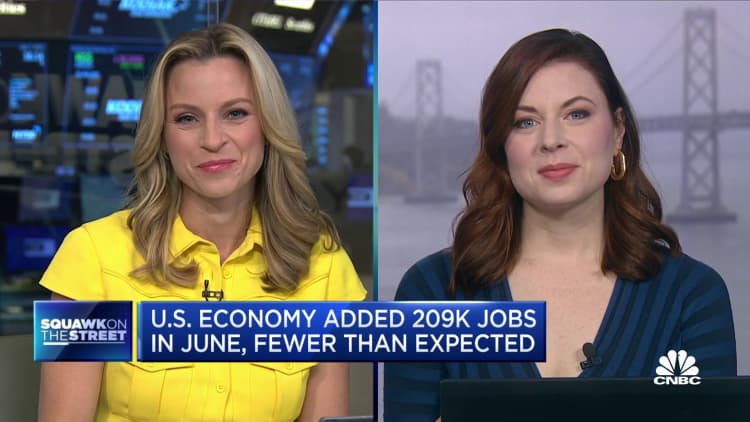Kmatta | Moment | Getty Images
For high school and college students, summer jobs are an opportunity to get used to earning a paycheck.
With that earned income, those young workers are also eligible to start investing in a Roth IRA.
Roth individual retirement accounts let workers set aside post-tax earnings toward retirement. In 2023, eligible workers may put up to $6,500 in a Roth IRA.
More from Personal Finance:
Quiet luxury may be Americans’ most expensive trend ever
Companies recognize importance of ‘out of office’ time
Cash-strapped consumers tip less amid persistent inflation
For young workers, opening a Roth IRA offers distinct advantages, experts say.
“The greatest money-making asset any person can possess is time, and young people have more of it than anyone,” said Ed Slott, an IRA expert and certified public accountant.
“They should capitalize on that time,” he added.
By starting to invest early, especially with the help of a parent or grandparent, they’re more likely to continue that habit into their professional earning years, Slott said.

A “strong” summer job market for teens is expected this season, according to a forecast from Rhode Island College. That includes a projected 33.6% teen employment rate over the summer months, up from 32.7% in 2022.
Teen wages have also increased in recent years to real median weekly pay of $300 in 2022, a 7% bump from $280 in 2019, the research notes.
To start investing all or some of those earnings in a Roth IRA, teens and the adults in their lives would be wise to consider several factors, experts say.
1. Study up on Roth IRA rules
Roth IRAs offer a distinct advantage in retirement: the opportunity to take tax-free withdrawals, since the money invested was already taxed.
But Roth IRAs also offer other advantages, particularly the ability to take contributions out at any time before retirement, tax and penalty free. Earnings may be withdrawn tax free only after the account holder is age 59½, and it has been five years since the tax year of the first Roth IRA contribution.
While teen workers are a long way from that age, getting started now is helpful because the five-year rule applies to the first contribution to any Roth IRA. It is a good idea to open a Roth IRA now to get the five-year rule going, Slott said.
Михаил Руденко | Istock | Getty Images
If you contribute even a nominal amount to a Roth IRA in 2023, that will count as your first year of the five years, Slott said.
Importantly, the limit that may be contributed to a Roth IRA is up to $6,500 for 2023, but young workers who earn less can contribute only up to the amount they earn.
Eligibility to contribute to a Roth IRA also generally depends on how much you earn. Since workers may no longer qualify for Roth IRAs later in their careers when their incomes are higher, that also makes it advantageous to get started with these accounts early.
Of note, the earned income that qualifies for Roth contributions can be W-2 earnings or self-employment income. But money that comes from babysitting or mowing lawns, for example, must be reported to the IRS to qualify for Roth IRA contributions.
“It actually is paired very well for children earning income for the first time during the summer,” Kelly Lannan, senior vice president of emerging customers at Fidelity Investments, said of Roth IRA accounts.
Fidelity typically sees a roughly 30% increase in openings of Fidelity Roth IRA for kids accounts between June and August, compared with the late April, early May time frame, according to the firm.
2. Loop in parents or grandparents
Generally, minors will need an adult to open and manage a Roth IRA on their behalf. The account is typically transferred to the child’s name when they reach age of majority, usually 18 or 21 depending on the state.
Having a parent, grandparent or other guardian involved can also help in other ways.
Slott said he started his own daughter with a Roth IRA when she started working one summer. He let her spend the modest sum she earned, then contributed that same sum to a Roth IRA on her behalf.
The strategy had two benefits, Slott said. It established the Roth IRA for the future and helped show the value of earning and saving.
The greatest money-making asset any person can possess is time, and young people have more of it than anyone.
Ed Slott
IRA expert and certified public accountant
“They’re more likely to continue it, especially if a parent or grandparent set it up for them, into their higher earning years,” Slott said.
Adults who contribute money on behalf of a minor must be mindful that they should not exceed the earnings. So, if a teen earns $4,000, for example, a parent or grandparent can only put in up to that sum.
However, if a teen earns more than $6,500, the maximum annual limit for 2023, contributions to the Roth IRA are capped at $6,500.
3. Consider other kinds of accounts
While Roth IRAs offer distinct advantages, opening a traditional savings account is also a popular route for teens looking to set aside money from their first jobs, Lannan said.
Those who open those accounts today have a distinct advantage with higher interest rates.
Many financial institutions also offer accounts specifically targeted at young savers and investors.
Early exposure to such accounts offers teens a way to start dabbling in investing and learn by doing, Lannan said. For example, by purchasing fractional shares, which include just a portion of a stock, teens may gain experience with trading by investing just a few dollars, Lannan said.

